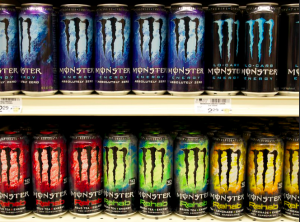12 The Changing Landscape of Caffeine
Brandon Shealy
Caffeine is the most commonly used substance in the world (Willson, 2018). In the United States, roughly 89% of the adult population uses caffeine daily, many of which rely on caffeine as a pick-me-up before the workday (Willson, 2018). It is commonly found in coffee, tea, sodas, and energy drinks. Caffeine has existed for centuries, but its use became more widespread during the industrial revolution. Workers looked to be energized for their shifts in the factories or just in the office (Gross, 2020). In recent years, sodas and energy drinks have become more popular among caffeine users as they typically contain higher levels of caffeine, thus providing more energy (Jacobsen, 2021). Since caffeine use is so prevalent in society, it is important to learn its history and how to maximize its benefits while minimizing the consequences.
The Science of Caffeine
Caffeine is a stimulant that increases thought-processing abilities and reduces drowsiness (Gupta et al., 2020). It reduces the effect that adenosine, a neurotransmitter that promotes fatigue, has on the brain. Caffeine can increase muscular endurance, strength, and several anaerobic and aerobic actions when performing exercise in both active and sedentary individuals (Guest et al., 2021). This drug typically takes 30 minutes to have an effect, but it can remain in the body for long periods of time, with a half-life of five to six hours (CDC, 2020).
Due to this, caffeine can disrupt sleep patterns. According to Michael Pollan in an interview with NPR in 2020, caffeine lessens the impact of deep sleep (Gross, 2020). During deep sleep, the brain syncs the neurons and processes memories (Gross, 2020).
Caffeine in the Past
Caffeine has been around for centuries, as it is a naturally occurring substance found in over 60 plant species, including coffee beans, cocoa beans, and tea leaves (Willson, 2018). The earliest documented use of caffeine dates back to 207 BC in China, as people consumed caffeine through tea leaves. This ritual remained the most common consumption method for another 1000 years (Willson, 2018). In 1000 AD, coffee became more popular, with people infusing coffee beans into boiling water (Willson, 2018). By the early 14th century, knowledge of caffeine’s stimulating effects became widespread, leading to the commercialization of tea and coffee across Arabia and Constantinople. Eventually, coffee and tea began to be shipped to the North American colonies in the seventeenth century (Willson, 2018). During this time, tea and coffee were primarily consumed by upper-class individuals in social settings (Fredholm, 2011). It was not until the late eighteenth-early nineteenth centuries and the dawn of the industrial revolution that caffeine became a substance people relied on to boost their energy levels (Gross, 2020). Around this time, caffeinated sodas were introduced, and the need for this energy now had many ways to be met. While coffee and tea remained the preferred way to consume caffeine, the development of caffeinated soda broadened the horizons of its consumption (Willson, 2018).

Caffeine in the Present
Recently, the physical benefits of caffeine have become a focus among teenagers and young adults. Because its effects can increase muscular endurance, strength, movement velocity, and anaerobic and aerobic actions during exercise (Guest et al., 2021). The desire for people to consume higher levels has grown significantly. As a result, energy drinks, a new way to consume caffeine, became increasingly popular. Energy drinks come in two categories: energy drinks and energy shots (USDHHS, 2018). Energy drinks are typically found in 16-ounce cans or bottles and contain anywhere from 70-300 milligrams of caffeine (USDHHS, 2018). Energy shots, on the other hand, can be found in 2-2.5 ounce containers and will contain 113-200 milligrams of caffeine (USDHHS, 2018). Due to their high concentration, energy drinks sales are seemingly the perfect fit for today’s fast-moving society, which has increased sales. In 2020, energy drinks and energy shots combined for $14 billion dollars in revenue and are projected to reach $20 billion in sales by 2024 (Jacobsen, 2021). Energy drink sales increased by 11.6% from 2019 to 2020 (Jacobsen, 2021). In order to continue growing in popularity, the energy drink industry has shifted focus from sugary drinks to fitness-based energy drinks, which contain natural ingredients and a blend of vitamins (Jacobsen, 2021). Although coffee and tea remain the most commonly consumed caffeinated drinks, energy drinks continue to rise in popularity.

Safe Use of Caffeine
While caffeine has numerous beneficial effects, it could cause adverse effects if used incorrectly. As mentioned previously, caffeine reduces adenosine’s effects (Guest et al., 2021). In the heart, adenosine blockage can lead to tachycardia (increased heart rate) and possibly cause arrhythmias if blocked for a long enough period of time (Cappelletti et al., 2015). Arrhythmias related to caffeine typically occur when individuals overconsume caffeine (Pickering & Grgic, 2019). This overconsumption can lead to increased anxiety and adversely affect sleep quality (Pickering & Grgic, 2019). To prevent these adverse effects, it is recommended that individuals consume 3-6 milligrams of caffeine per kilogram of body weight (Pickering & Grgic, 2019). Additionally, since caffeine lingers in the body for over six hours, it is recommended to consume caffeine at least six hours before bed (Gross, 2020).
Conclusion
Caffeine has been one of the most popular drugs throughout history. Beginning with the use of tea leaves, then coffee, sodas, and currently energy drinks, caffeinated beverages are changing to adapt to the population’s current needs. With these changes and the subsequent increase in caffeine in these beverages, it is important to know how caffeine works and how to use it safely.
Review Questions
1. What type of drug is caffeine?
a. Opioid
b. Stimulant
c. Hallucinogen
d. Amphetamine
2. How long does caffeine remain in the body?
a. Five hours
b. Four hours
c. Thirty minutes
d. Over six hours
3. What is considered a safe dose of caffeine?
a. 2-4 mg/kg of body weight
b. 600 mg a day regardless of body weight
c. 3-6 mg/kg of body weight
d. 1-3 mg/kg of body weight
References
Cappelletti, S., Piacentino, D., Sani, G., & Aromatario, M. (2015). Caffeine: cognitive and physical performance enhancer or psychoactive drug?. Current Neuropharmacology, 13(1), 71–88. https://doi.org/10.2174/1570159X13666141210215655
Centers for Disease Control and Prevention. (2020, April 1). Caffeine & long work hours. https://www.cdc.gov/niosh/emres/longhourstraining/caffeine.html
Fredholm B. B. (2011). Notes on the history of caffeine use. Handbook of Experimental Pharmacology, (200), 1–9. https://doi.org/10.1007/978-3-642-13443-2_1
Gross, T. (2020, February 10). Michael Pollan explains caffeine cravings (and why you don’t have to quit). NPR. https://www.npr.org/sections/health-shots/2020/02/10/803394030/michael-pollan-explains-caffeine-cravings-and-why-you-dont-have-to-quit
Guest, N. S., VanDusseldorp, T. A., Nelson, M. T., Grgic, J., Schoenfeld, B. J., Jenkins, N. D. M., Arent, S. M., Antonio, J., Stout, J. R., Trexler, E. T., Smith-Ryan, A. E., Goldstein, E. R., Kalman, D. S., Campbell, B. I. (2021, December 1). International society of sports nutrition position stand: Caffeine and exercise performance. Journal of the International Society of Sports Nutrition. 18(1). 1-37. https://doi.org/10.1186/s12970-020-00383-4
Gupta, P. K., Himashankari, B., Sinha, A., Reddy, K. A., Priyadharsini , V., Hiremath, L., & Srivastava, A. K. (2020). Caffeine: Benefits, risks and effects-A review. Indian Journal of Public Health Research & Development. 11(3). 377-382. https://doi.org/10.37506/ijphrd.v11i3.1161
Jacobsen, J. (2021, July 1). 2021 state of the beverage industry: Energy drinks flourish as consumers seek functionality. Beverage Industry RSS. https://www.bevindustry.com/articles/94255-state-of-the-beverage-industry-energy-drinks-flourish-as-consumers-seek-functionality#:~:text=(IRI)%2C%20the%20overall%20energy,billion%20in%20energy%20drink%20sales.
Pickering, C., & Grgic, J. (2019). Caffeine and exercise: What next?. Sports Medicine. 49(7), 1007–1030. https://doi.org/10.1007/s40279-019-01101-0
U.S. Department of Health and Human Services. (2018, July). Energy drinks. National Center for Complementary and Integrative Health. https://www.nccih.nih.gov/health/energy-drinks
Willson C. (2018). The clinical toxicology of caffeine: A review and case study. Toxicology Reports. 5. 1140–1152. https://doi.org/10.1016/j.toxrep.2018.11.002
an agent (such as a drug) that produces a temporary increase of the functional activity or efficiency of an organism or any of its parts
molecules within the brain that act as chemical messengers between neurons, either causing or stopping the continuation of an electrical signal on the neighboring neuron
the ability of muscle to sustain a prolonged stressful effort or activity
of, relating to, or being activity in which the body incurs an oxygen debt
of or relating to the body's ability to consume oxygen during exercise
not physically active
the time required for half the amount of a substance (such as a drug, radioactive tracer, or pesticide) in or introduced into a living system or ecosystem to be eliminated or disintegrated by natural processes
an alteration in rhythm of the heartbeat either in time or force

